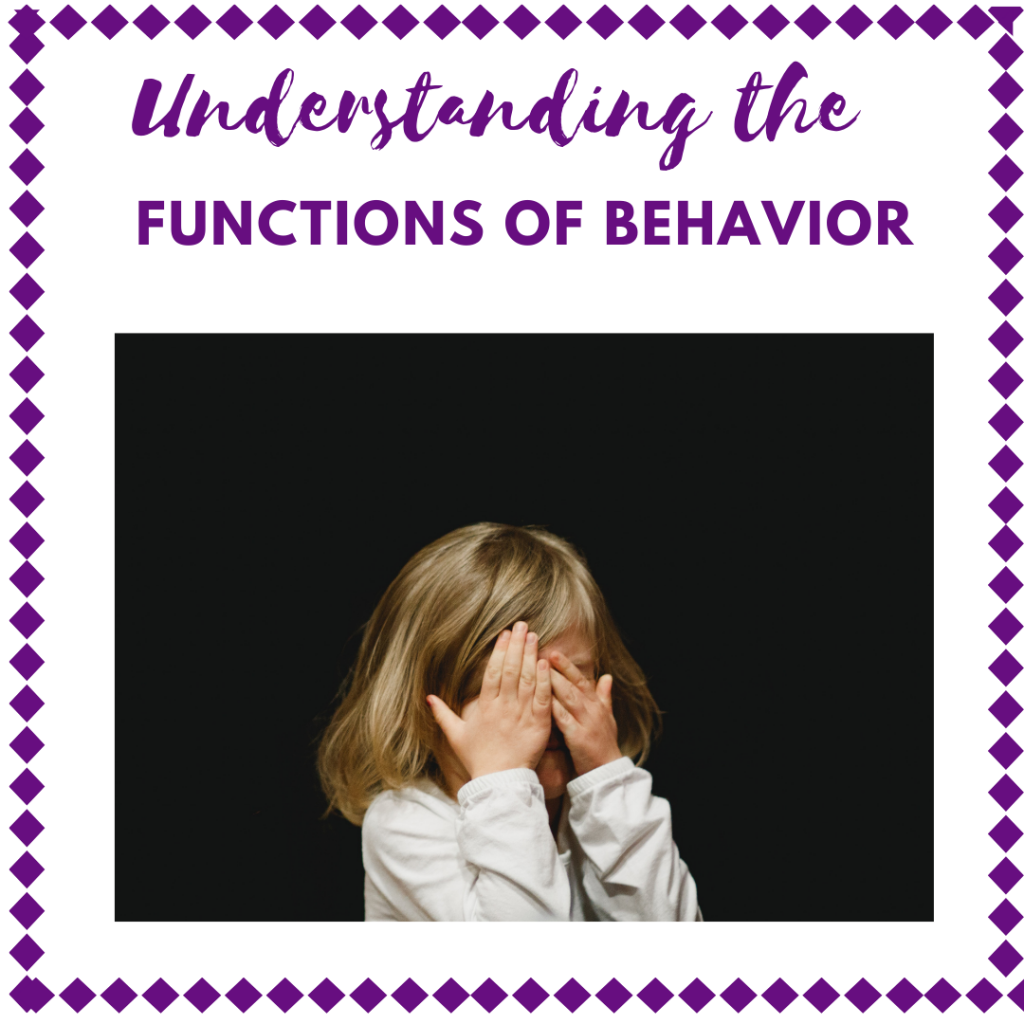
Guest Post from Beth Marie at Behaviour Babble
Have you ever walked past a cranky child wailing at their parent in the supermarket? Or has it ever been your child who has acted out, pushing your buttons and in the moment you just didn’t know how to make them happy again and restore the calm? Don’t worry, we have all been there! But learning about problem behaviour is easier than you might think, especially when you have the functions of behaviour in your toolkit. Today we are going to consider one researched-backed approach to understanding problem behaviour and why you could benefit from learning about it.
According to behavioural science, we tend to behave in a certain way to get something we want from the world around us. All behaviour serves a purpose, or a function, for that person. This is true, even if as adults we might perceive an action to be appropriate or inappropriate for the situation. ABA proposes that most behaviour occurs because it serves one of four key functions.
Escape, we do something to avoid or remove an activity that we do not enjoy.
Attention, we do something to gain social response from someone else.
Tangible, we do something to obtain a physical item or activity.
Sensory, we do something because it stimulates one or more of our senses. E.g. The behaviour feels, tastes, looks, sounds or smells good. Usually we can tell if a behaviour is motivated by a sensory function, because they do not need to be accessed through another person. The person will continue the behaviour alone in their own company i.e. spinning objects constantly.
Four examples of the functions of behaviour
Escape: Kristin hates Dance classes on a Monday morning. When the class starts each week, Kirstin screams until she is allowed to sit outside the room, in a comfy chair and talk to her teaching assistant until the class is over.
Attention: Josh is sat at the dinner table, while his parents are deep in conversation about their work. Josh throws some of his pasta onto the floor and his mother tells him firmly not to make a mess. Josh giggles and continues flinging pasta until dinner has finished.
Tangible: Fatima asks her father to unlock the storage cupboard so she can get her game of snap.
Sensory: Liam loves the noises that vacuum cleaners make. He regularly hums the sounds to himself in the livingroom with his family, outside at the park and even when he is alone.
Now you know what the functions of behaviour are, let’s discuss why this approach is useful in terms of redirecting problem behaviour.
Why is it helpful to know about the functions of behaviour?When you can recognise the function of a behaviour, you begin to understand why the behaviour is occurring. Once you know which consequence is maintaining a problem behaviour (access to escape, attention, tangible’s or sensory stimulation) you can identifyhow your child could access the function that they want, with a more appropriate alternative.
Let me bring in an example to explain.
Brendon hits his brother Mike, in order to play with the train set that Mike was holding. You have identified ‘hitting’ as a problem behaviour, since you want to teach your children to resolve problems in a kind way, without aggression.
You have also noticed that Brendon tends to hit his brother when he is holding a toy that Brendon enjoys playing with. This means that Brendon’s behaviour of ‘hitting’ has the function of seeking accesses to tangible items (toys).
Now here comes my favourite part, teaching fresh and functionally alternative behaviours!
You can focus on teaching a more appropriate way for Brendon to access what he wants (playing with certain toys). This could be taught by showing Brendon how to communicate his needs with his brother, using a vocal phrase, a Makaton sign or a “time to share card” to name a few suggestions. I’m sure Rose has many more brilliant ideas on how this skill could be taught!
Over time, Brendon should learn that he can play with his brother’s toys easily by just communicating with him. The problem behaviour should naturally reduce, especially if you combine teaching the new appropriate behaviour with excited speicifc praise and recognition, such as “I am so impressed that you used your signs to ask for playing with the trains!”
It also helps to think proactively and arrange the environment so your child can be successful. For example, have multiple exciting toys available while you are in the early stages of teaching sharing. This gives your children less motivation to fight over toys.
Before you head out into the world putting what you have learned to good use, please keep the following things in mind.
3 Tips to using the functions of behaviour effectively
1) Reducing problem behaviour can be tricky to do on your own. You can find out information about licenced ABA professional’s at www.bacb.com
2) Ensure you consider any medical issues first, before looking at the functions of behaviour. For example, a child might be running away from completing their worksheets because they are experiencing extreme stomach pain, which they cannot articulate and which has been left untreated, rather than because they are simply escaping from the task itself.
3) Life works in complex ways. Sometimes behaviour might be tricky to pin down onto one function. This is because some behaviours have more than one function. I never said that understanding behaviour was easy!
For example, a child shouts to get noticed by their busy working sister (attention) and to have a time out break from being in the supermarket (escape).
How to remember the four functions of behaviour?An easy way of recalling the four functions of behaviour at lightning fast speed is with the acronym Everybody “E.A.T.S” . E stands for Escape, A stands for Attention, T stands for Tangible and S stands for Sensory.
This nifty memory tool helped me to learn this concept and apply it within my day to day work as an ABA tutor for children with autism. After all, if something is easy to remember, you will be able to use it to understand more of the moments that matter to you. In fact, I can still recall the functions of behaviour quickly even after several years have passed (more than I would care to admit!) since I first studied ABA. I’m fortunate enough to be in a job where I can directly apply the techniques which I learned at university and which I wholeheartedly believe in to this day.
Final thoughts
I hope that this post has given you a deeper insight into behaviour and how you can better understand the actions of your child and perhaps even yourself.

0 Comments